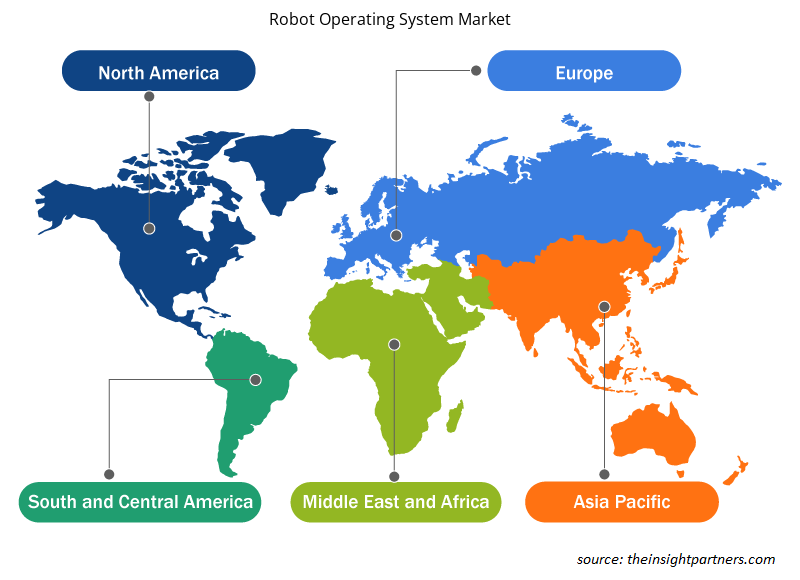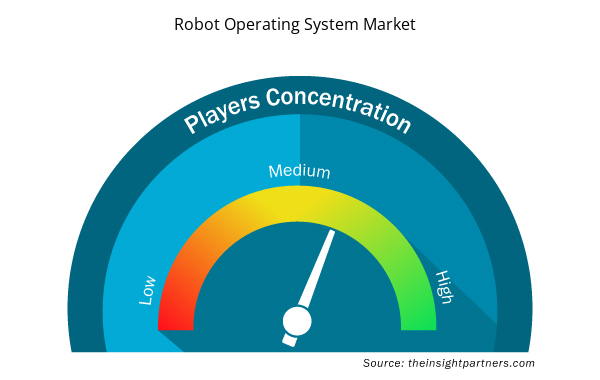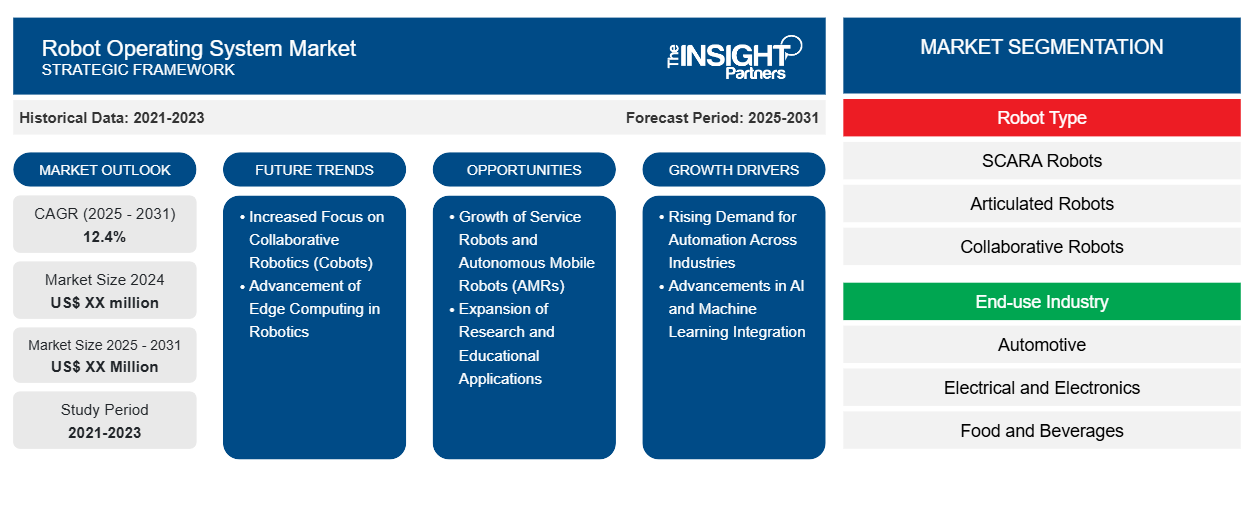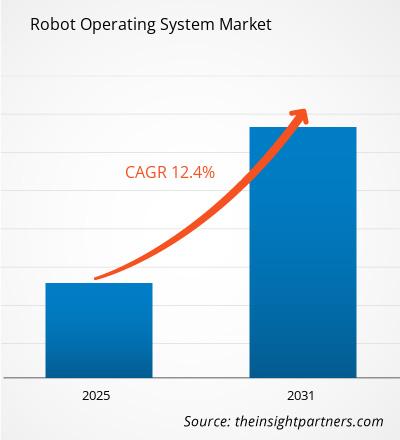Se espera que el mercado de sistemas operativos robóticos registre una CAGR del 12,4 % entre 2023 y 2031, con un tamaño de mercado que se expandirá de US$ XX millones en 2023 a US$ XX millones en 2031.
El informe está segmentado por tipo de robot (robots SCARA, robots articulados, robots colaborativos, robots cartesianos, robots paralelos, otros); industria de uso final (automotriz, eléctrica y electrónica, alimentos y bebidas, atención médica, metal y maquinaria, otros). El análisis global se desglosa aún más a nivel regional y por países principales. El informe ofrece el valor en USD para el análisis y los segmentos anteriores.
Propósito del Informe
El informe Robot Operating System Market de The Insight Partners tiene como objetivo describir el panorama actual y el crecimiento futuro, los principales factores impulsores, los desafíos y las oportunidades. Esto proporcionará información a diversas partes interesadas del negocio, como:
- Proveedores/fabricantes de tecnología: Para comprender la dinámica cambiante del mercado y conocer las oportunidades potenciales de crecimiento, lo que les permitirá tomar decisiones estratégicas informadas.
- Inversionistas: Realizar un análisis exhaustivo de tendencias sobre la tasa de crecimiento del mercado, las proyecciones financieras del mercado y las oportunidades que existen en toda la cadena de valor.
- Órganos reguladores: Regular las políticas y vigilar las actividades del mercado con el objetivo de minimizar los abusos, preservar la confianza de los inversores y defender la integridad y estabilidad del mercado.
Segmentación del mercado de sistemas operativos para robots
Tipo de robot
- Robots SCARA
- Robots articulados
- Robots colaborativos
- Robots cartesianos
- Robots paralelos
- Otros
Industria de uso final
- Automotor
- Electricidad y electrónica
- Alimentos y bebidas
- Cuidado de la salud
- Metal y Maquinaria
- Otros
Personalice este informe según sus necesidades
Obtendrá personalización en cualquier informe, sin cargo, incluidas partes de este informe o análisis a nivel de país, paquete de datos de Excel, así como también grandes ofertas y descuentos para empresas emergentes y universidades.
- Obtenga las principales tendencias clave del mercado de este informe.Esta muestra GRATUITA incluirá análisis de datos, desde tendencias del mercado hasta estimaciones y pronósticos.
Factores impulsores del crecimiento del mercado de sistemas operativos robóticos
- Demanda creciente de automatización en todas las industrias: la creciente adopción de la automatización en diversas industrias, incluidas la fabricación, la logística, la atención médica y la agricultura, es un factor importante para el mercado de sistemas operativos robóticos (ROS). ROS proporciona un marco flexible y modular que permite a los desarrolladores construir y controlar sistemas robóticos de manera eficiente, lo que lo hace ideal para robots industriales, vehículos autónomos y robots de servicio. A medida que las industrias buscan formas de mejorar la productividad, reducir los costos y mejorar la precisión a través de la automatización, la demanda de plataformas ROS para respaldar estos sistemas robóticos está creciendo rápidamente.ROS) market. ROS provides a flexible and modular framework that enables developers to build and control robotic systems efficiently, making it ideal for industrial robots, autonomous vehicles, and service robots. As industries look for ways to enhance productivity, reduce costs, and improve precision through automation, the demand for ROS platforms to support these robotic systems is growing rapidly.
- Avances en la integración de la IA y el aprendizaje automático: la integración de las tecnologías de inteligencia artificial (IA) y aprendizaje automático (ML) con la robótica es otro factor clave del mercado de ROS. ROS es altamente compatible con algoritmos de IA y ML, lo que permite a los robots realizar tareas complejas, adaptarse a entornos cambiantes y tomar decisiones en tiempo real. La capacidad de integrar capacidades avanzadas de percepción, navegación y toma de decisiones a través de ROS está acelerando su adopción, en particular en áreas como vehículos autónomos, drones y sistemas de fabricación inteligentes.ROS market. ROS is highly compatible with AI and ML algorithms, enabling robots to perform complex tasks, adapt to changing environments, and make real-time decisions. The ability to integrate advanced perception, navigation, and decision-making capabilities through ROS is accelerating its adoption, particularly in areas such as autonomous vehicles, drones, and intelligent manufacturing systems.
Tendencias futuras del mercado de sistemas operativos para robots
- Mayor atención a la robótica colaborativa (cobots): una tendencia destacada en el mercado de ROS es el auge de los robots colaborativos, o cobots, que están diseñados para trabajar junto a operadores humanos en espacios de trabajo compartidos. Estos robots dependen en gran medida de ROS para la coordinación, la toma de decisiones en tiempo real y el control de la seguridad. A medida que más industrias, como la fabricación, la logística y la atención médica, adoptan cobots para mejorar la productividad y la seguridad, aumenta la demanda de plataformas impulsadas por ROS que puedan manejar interacciones complejas entre humanos y robots. La arquitectura modular de ROS lo hace ideal para desarrollar los sistemas adaptables y flexibles necesarios para las aplicaciones de cobots.
- Avances de la computación de borde en la robótica: la integración de la computación de borde con la robótica es otra tendencia emergente en el mercado de ROS. La computación de borde permite a los robots procesar datos localmente en el dispositivo en lugar de enviarlos a un servidor centralizado, lo que reduce la latencia y mejora las capacidades de toma de decisiones en tiempo real. Gracias a que ROS es compatible con los marcos de computación de borde, los robots pueden manejar tareas más complejas, como la navegación en tiempo real y la toma de decisiones autónoma, sin depender en gran medida de la infraestructura de la nube. Esta tendencia es particularmente importante en aplicaciones donde la baja latencia y las respuestas en tiempo real son fundamentales, como en vehículos autónomos, drones y robots industriales.
Oportunidades de mercado para sistemas operativos de robots
- Crecimiento de los robots de servicio y los robots móviles autónomos (AMR): el creciente uso de robots de servicio en sectores como la atención sanitaria, la hostelería y el comercio minorista presenta una oportunidad significativa para el mercado de ROS. Los robots de servicio, incluidos los robots de reparto, los robots de limpieza y los asistentes sanitarios, dependen en gran medida de los ROS para la navegación, el reconocimiento de objetos y la gestión de tareas. La creciente demanda de robots móviles autónomos (AMR) en almacenes, centros de distribución y servicios de entrega de última milla también crea importantes oportunidades de crecimiento. Los ROS pueden proporcionar las herramientas necesarias para una integración perfecta y un rendimiento mejorado de estos robots, lo que crea un gran potencial de mercado en la robótica de servicios y la automatización de la logística.
- Expansión de las aplicaciones de investigación y educación: Otra oportunidad para el mercado de ROS radica en el uso cada vez mayor de ROS en instituciones académicas y de investigación. Como ROS es de código abierto y altamente personalizable, se utiliza cada vez más en entornos educativos para enseñar robótica, IA y automatización. Muchas universidades y laboratorios de investigación utilizan ROS para desarrollar sistemas robóticos experimentales y realizar experimentos en diferentes dominios, como ingeniería robótica, IA e IoT. El crecimiento de los programas educativos centrados en la robótica y la educación STEM (ciencia, tecnología, ingeniería y matemáticas) está impulsando la adopción de plataformas ROS, creando nuevos mercados para herramientas y recursos educativos creados sobre ROS.
Perspectivas regionales del mercado de sistemas operativos robóticos
Los analistas de Insight Partners explicaron en detalle las tendencias y los factores regionales que influyen en el mercado de sistemas operativos para robots durante el período de pronóstico. Esta sección también analiza los segmentos y la geografía del mercado de sistemas operativos para robots en América del Norte, Europa, Asia Pacífico, Oriente Medio y África, y América del Sur y Central.

- Obtenga datos regionales específicos para el mercado de sistemas operativos de robots
Alcance del informe de mercado de sistemas operativos robóticos
| Atributo del informe | Detalles |
|---|---|
| Tamaño del mercado en 2023 | XX millones de dólares estadounidenses |
| Tamaño del mercado en 2031 | US$ XX millones |
| CAGR global (2023 - 2031) | 12,4% |
| Datos históricos | 2021-2022 |
| Período de pronóstico | 2024-2031 |
| Segmentos cubiertos | Por tipo de robot
|
| Regiones y países cubiertos | América del norte
|
| Líderes del mercado y perfiles de empresas clave |
|
Densidad de actores del mercado de sistemas operativos robóticos: comprensión de su impacto en la dinámica empresarial
El mercado de sistemas operativos para robots está creciendo rápidamente, impulsado por la creciente demanda de los usuarios finales debido a factores como la evolución de las preferencias de los consumidores, los avances tecnológicos y una mayor conciencia de los beneficios del producto. A medida que aumenta la demanda, las empresas amplían sus ofertas, innovan para satisfacer las necesidades de los consumidores y aprovechan las tendencias emergentes, lo que impulsa aún más el crecimiento del mercado.
La densidad de actores del mercado se refiere a la distribución de las empresas o firmas que operan dentro de un mercado o industria en particular. Indica cuántos competidores (actores del mercado) están presentes en un espacio de mercado determinado en relación con su tamaño o valor total de mercado.
Las principales empresas que operan en el mercado de sistemas operativos para robots son:
- Compañía: ABB Ltd.
- Robótica Clearpath
- Corporación DENSO
- Corporación FANUC
- KUKA AG
Descargo de responsabilidad : Las empresas enumeradas anteriormente no están clasificadas en ningún orden particular.

- Obtenga una descripción general de los principales actores clave del mercado de sistemas operativos para robots
Puntos de venta clave
- Cobertura integral: el informe cubre de manera integral el análisis de productos, servicios, tipos y usuarios finales del mercado de sistemas operativos robóticos, proporcionando un panorama holístico.
- Análisis de expertos: el informe se compila sobre la base de un profundo conocimiento de expertos y analistas de la industria.
- Información actualizada: El informe asegura relevancia comercial debido a su cobertura de información reciente y tendencias de datos.
- Opciones de personalización: este informe se puede personalizar para satisfacer los requisitos específicos del cliente y adaptarse adecuadamente a las estrategias comerciales.
Por lo tanto, el informe de investigación sobre el mercado de sistemas operativos para robots puede ayudar a abrir camino para descifrar y comprender el escenario de la industria y las perspectivas de crecimiento. Si bien puede haber algunas preocupaciones válidas, los beneficios generales de este informe tienden a superar las desventajas.
- Análisis histórico (2 años), año base, pronóstico (7 años) con CAGR
- Análisis PEST y FODA
- Tamaño del mercado Valor/volumen: global, regional, nacional
- Industria y panorama competitivo
- Conjunto de datos de Excel



Report Coverage
Revenue forecast, Company Analysis, Industry landscape, Growth factors, and Trends

Segment Covered
This text is related
to segments covered.

Regional Scope
North America, Europe, Asia Pacific, Middle East & Africa, South & Central America

Country Scope
This text is related
to country scope.
Preguntas frecuentes
Some of the customization options available based on the request are an additional 3-5 company profiles and country-specific analysis of 3-5 countries of your choice. Customizations are to be requested/discussed before making final order confirmation# as our team would review the same and check the feasibility
The report can be delivered in PDF/PPT format; we can also share excel dataset based on the request
The integration of artificial intelligence (AI) and machine learning (ML) with ROS is anticipated to play a significant role in the global Robot Operating System market in the coming years
The major factors driving the Robot Operating System market are Increased Adoption in Industries and Expansion of E-commerce.
The Robot Operating System Market is estimated to witness a CAGR of 12.4% from 2023 to 2031
-
Trends and growth analysis reports related to Electronics and Semiconductor : READ MORE..
1. ABB Ltd.2. Clearpath Robotics3. DENSO Corporation4. FANUC Corporation5. KUKA AG6. Microsoft Corporation7. Omron Corporation8. Rethink Robotics GmbH9. Universal Robots10. Yaskawa Electric Corporation
The Insight Partners performs research in 4 major stages: Data Collection & Secondary Research, Primary Research, Data Analysis and Data Triangulation & Final Review.
- Data Collection and Secondary Research:
As a market research and consulting firm operating from a decade, we have published and advised several client across the globe. First step for any study will start with an assessment of currently available data and insights from existing reports. Further, historical and current market information is collected from Investor Presentations, Annual Reports, SEC Filings, etc., and other information related to company’s performance and market positioning are gathered from Paid Databases (Factiva, Hoovers, and Reuters) and various other publications available in public domain.
Several associations trade associates, technical forums, institutes, societies and organization are accessed to gain technical as well as market related insights through their publications such as research papers, blogs and press releases related to the studies are referred to get cues about the market. Further, white papers, journals, magazines, and other news articles published in last 3 years are scrutinized and analyzed to understand the current market trends.
- Primary Research:
The primarily interview analysis comprise of data obtained from industry participants interview and answers to survey questions gathered by in-house primary team.
For primary research, interviews are conducted with industry experts/CEOs/Marketing Managers/VPs/Subject Matter Experts from both demand and supply side to get a 360-degree view of the market. The primary team conducts several interviews based on the complexity of the markets to understand the various market trends and dynamics which makes research more credible and precise.
A typical research interview fulfils the following functions:
- Provides first-hand information on the market size, market trends, growth trends, competitive landscape, and outlook
- Validates and strengthens in-house secondary research findings
- Develops the analysis team’s expertise and market understanding
Primary research involves email interactions and telephone interviews for each market, category, segment, and sub-segment across geographies. The participants who typically take part in such a process include, but are not limited to:
- Industry participants: VPs, business development managers, market intelligence managers and national sales managers
- Outside experts: Valuation experts, research analysts and key opinion leaders specializing in the electronics and semiconductor industry.
Below is the breakup of our primary respondents by company, designation, and region:

Once we receive the confirmation from primary research sources or primary respondents, we finalize the base year market estimation and forecast the data as per the macroeconomic and microeconomic factors assessed during data collection.
- Data Analysis:
Once data is validated through both secondary as well as primary respondents, we finalize the market estimations by hypothesis formulation and factor analysis at regional and country level.
- Macro-Economic Factor Analysis:
We analyse macroeconomic indicators such the gross domestic product (GDP), increase in the demand for goods and services across industries, technological advancement, regional economic growth, governmental policies, the influence of COVID-19, PEST analysis, and other aspects. This analysis aids in setting benchmarks for various nations/regions and approximating market splits. Additionally, the general trend of the aforementioned components aid in determining the market's development possibilities.
- Country Level Data:
Various factors that are especially aligned to the country are taken into account to determine the market size for a certain area and country, including the presence of vendors, such as headquarters and offices, the country's GDP, demand patterns, and industry growth. To comprehend the market dynamics for the nation, a number of growth variables, inhibitors, application areas, and current market trends are researched. The aforementioned elements aid in determining the country's overall market's growth potential.
- Company Profile:
The “Table of Contents” is formulated by listing and analyzing more than 25 - 30 companies operating in the market ecosystem across geographies. However, we profile only 10 companies as a standard practice in our syndicate reports. These 10 companies comprise leading, emerging, and regional players. Nonetheless, our analysis is not restricted to the 10 listed companies, we also analyze other companies present in the market to develop a holistic view and understand the prevailing trends. The “Company Profiles” section in the report covers key facts, business description, products & services, financial information, SWOT analysis, and key developments. The financial information presented is extracted from the annual reports and official documents of the publicly listed companies. Upon collecting the information for the sections of respective companies, we verify them via various primary sources and then compile the data in respective company profiles. The company level information helps us in deriving the base number as well as in forecasting the market size.
- Developing Base Number:
Aggregation of sales statistics (2020-2022) and macro-economic factor, and other secondary and primary research insights are utilized to arrive at base number and related market shares for 2022. The data gaps are identified in this step and relevant market data is analyzed, collected from paid primary interviews or databases. On finalizing the base year market size, forecasts are developed on the basis of macro-economic, industry and market growth factors and company level analysis.
- Data Triangulation and Final Review:
The market findings and base year market size calculations are validated from supply as well as demand side. Demand side validations are based on macro-economic factor analysis and benchmarks for respective regions and countries. In case of supply side validations, revenues of major companies are estimated (in case not available) based on industry benchmark, approximate number of employees, product portfolio, and primary interviews revenues are gathered. Further revenue from target product/service segment is assessed to avoid overshooting of market statistics. In case of heavy deviations between supply and demand side values, all thes steps are repeated to achieve synchronization.
We follow an iterative model, wherein we share our research findings with Subject Matter Experts (SME’s) and Key Opinion Leaders (KOLs) until consensus view of the market is not formulated – this model negates any drastic deviation in the opinions of experts. Only validated and universally acceptable research findings are quoted in our reports.
We have important check points that we use to validate our research findings – which we call – data triangulation, where we validate the information, we generate from secondary sources with primary interviews and then we re-validate with our internal data bases and Subject matter experts. This comprehensive model enables us to deliver high quality, reliable data in shortest possible time.


 Obtenga una muestra gratuita de este informe
Obtenga una muestra gratuita de este informe